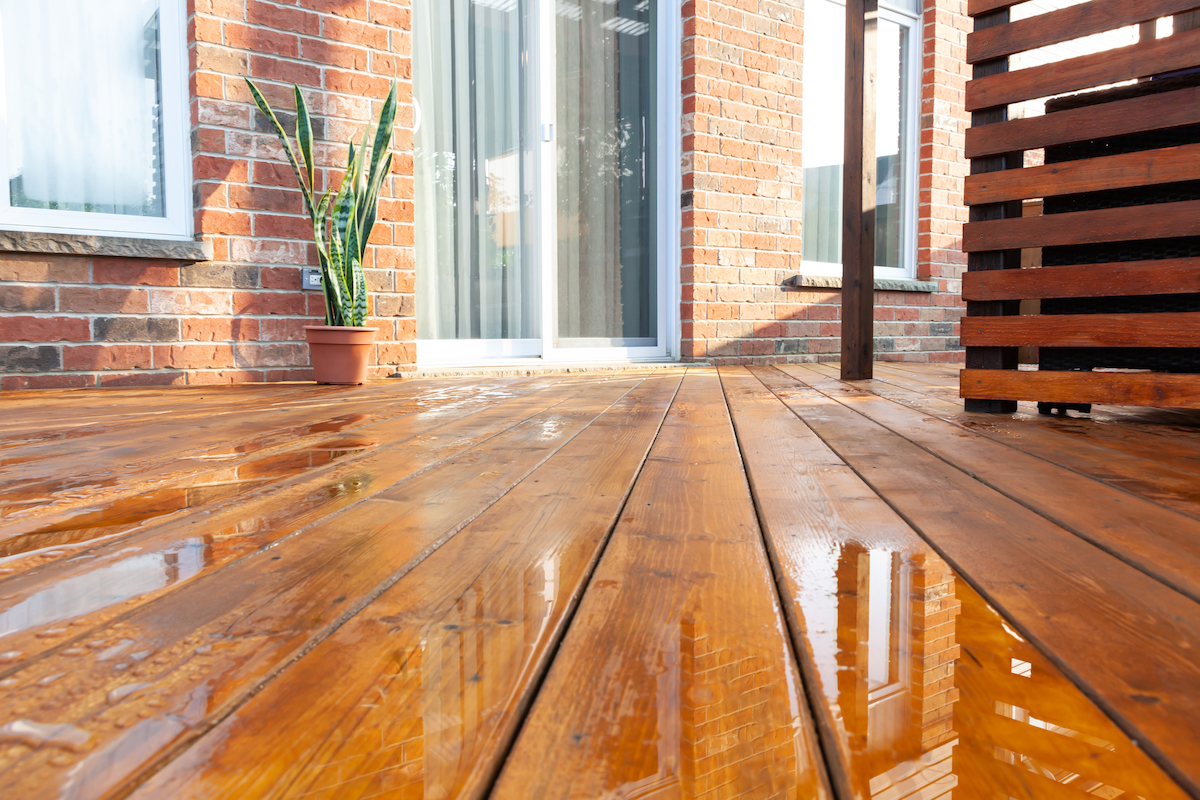We may earn revenue from the products available on this page and participate in affiliate programs. Learn More ›
An outdoor deck sees lots of traffic. Muddy shoes, spilled food, and wet dogs can leave it dirty, stained, and smelly. Even if the deck isn’t a party platform, it’s up against the elements—pollen, leaves, and algae all take their toll.
But you needn’t use a harsh, expensive deck detergent to restore it. For a refreshed deck in a matter of hours, mix up a batch of homemade deck cleaner, apply it with a deck brush and a little elbow grease, and then rinse away all manner of dirt and grime.
Why choose a DIY deck cleaner?
Using a commercial deck cleaner that contains harsh ingredients and toxic chemicals on a deck can poison nearby grass and other plantings—it’s a safer for plants, people, and pets to use a cleaner that contains only nontoxic ingredients. The OxiClean in the following homemade solution contains sodium percarbonate, a hydrogen peroxide derivative. It can remove a variety of tough stains and spills. Best of all, it’s eco-safe and won’t harm plants or pollute the environment.
Tools & Materials
Bobvila.com may earn a commission from purchases made through these links.
How to Use Homemade Deck Cleaner
Successful use of any deck cleaner involves some prep first, like removing furniture and other items and then rinsing the deck surface. Then, it will be time to mix and apply the homemade cleaner and rinse again to refresh your deck.
Step 1: Clear off the deck and spray it down with a garden hose.
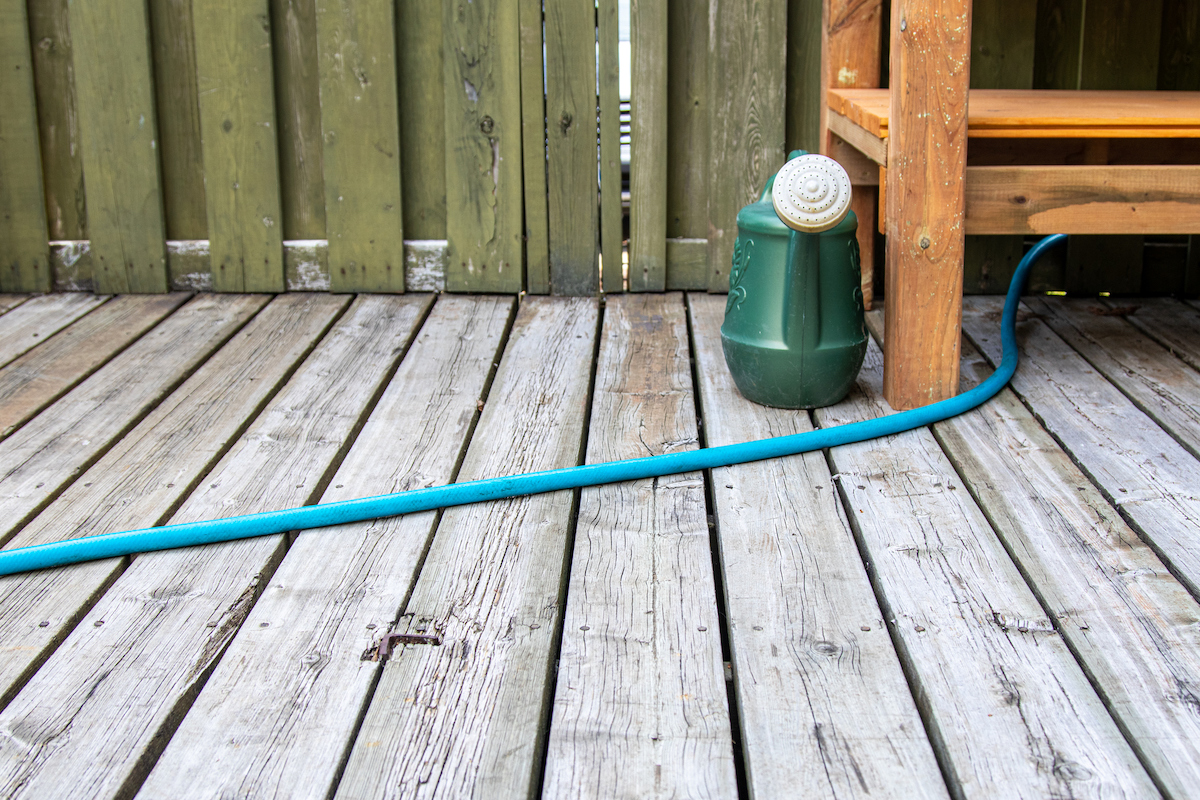
Clear the deck of furniture, grill, toys, gardening containers, and any other miscellaneous outdoor equipment and stash them elsewhere. Sweep away leaves and other loose debris. Spray the decking with water from your garden hose to loosen and soften stuck mud and debris, making it easier to remove. If you plan to clean the deck railings, sweep and rinse them as part of this initial step.
Step 2: Prepare the deck-cleaning solution.
Before mixing your homemade deck cleaning solution, grab the tools, materials, and ingredients you will need, including measuring cups and a stick to stir the solution. This will help the water stay warmer longer so you can more easily dissolve and mix ingredients. The ingredients are relatively safe, but it’s a good idea to wear goggles and rubber gloves to protect sensitive eyes and skin, should the homemade deck cleaner splash.
- Start by pouring 2 gallons of warm water into a plastic bucket large enough to accommodate the head of a deck brush, which is the best tool to reach into grooves between boards. (You can or a regular scrub brush if that’s all you have on hand.)
- Add 2 cups of powdered oxygen bleach like OxiClean; it is milder than liquid chlorine bleach.
- If your deck surface has visible mildew stains, add 1 cup of powdered Borax to the solution with the oxygen bleach.
- Stir gently until the powdered bleach dissolves completely.
- Add ¼ cup of liquid dish soap and stir just enough to mix the solution.
Step 3: Apply the cleaning solution and scrub the deck.
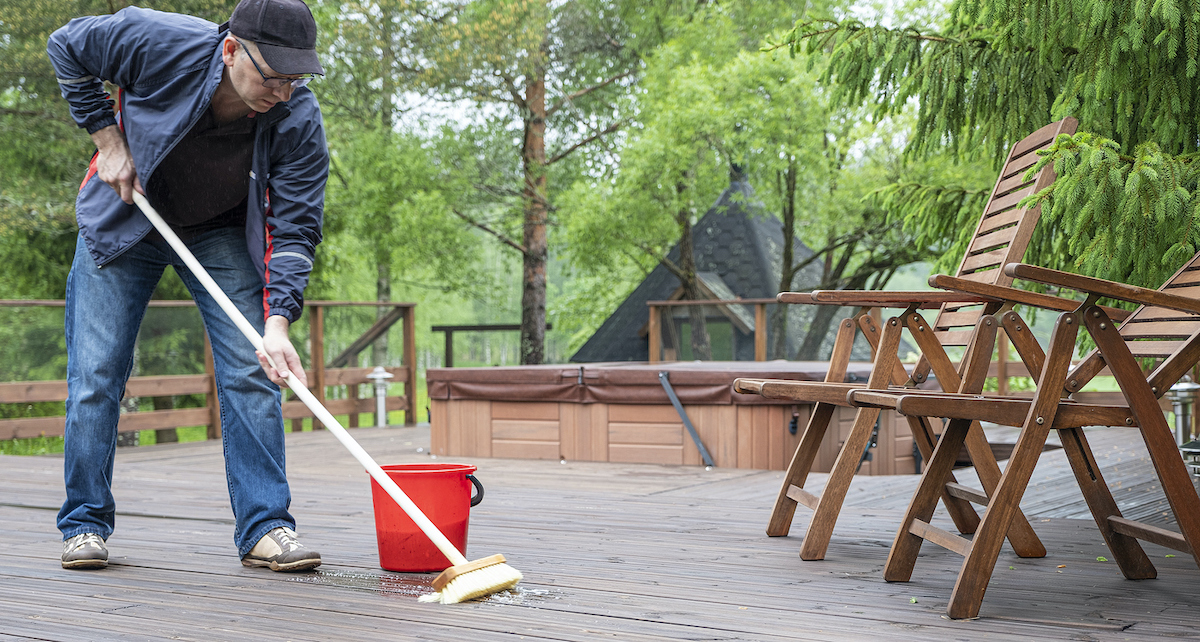
Starting at one end and working your way to the house entrance or deck stairs, liberally saturate the deck surface by dipping the brush into the homemade cleaning solution and sloshing it over the decking planks. Clean your deck with the brush in the direction of the grain and work up a light lather, rewetting the brush’s bristles as needed.
Give the solution 15 minutes of soaking time to allow the oxygen bleach to work.
“Cleaning a deck extends its service life by removing micro organisms the wood doesn’t like, like leaves between boards that eventually turn to dirt. Cleaning a deck also make it possible to add new sealant, which wood decks should receive every one or two years. For composite, it freshens the deck up, removes material from between deck boards and prevents build-up of algae and mold, especially in wood grain patterns and vertical surfaces like PVC post-sleeves.”
—Mark Clement, Co-owner of Ambler, PA-based Clement Improvements and MyFixitUpLife
Step 4: Rinse the decking off with a garden hose.
Rinse the DIY deck cleaner with the garden hose. Let your deck dry completely before returning furniture and other items to the area. If you’re planning to seal or stain a wood deck after washing it, wait until the deck dries completely, which can take as much as 24 hours, depending on weather conditions. Waiting keeps the bleach ingredients from reacting with chemicals.
It’s also a good idea to wait until the deck dries before undertaking deck repairs, such as replacing rusty deck screws or reinforcing deck boards, and before restoring a weathered wood deck.
Step 5: Address remaining dirt or stains.
If your deck is particularly dirty, you might have to repeat this entire process. If only small portions have leaf stains or other grime remaining, try mixing up a paste.
In a small container, mix a small amount of warm water with OxiClean powder to form a paste that is damp enough to spread but much more concentrated than the homemade deck cleaner. Apply and rub the paste in with a small bristle brush, letting it sit on the stain for about 30 minutes before rinsing.
Step 6: Clean the deck stairs and rails.
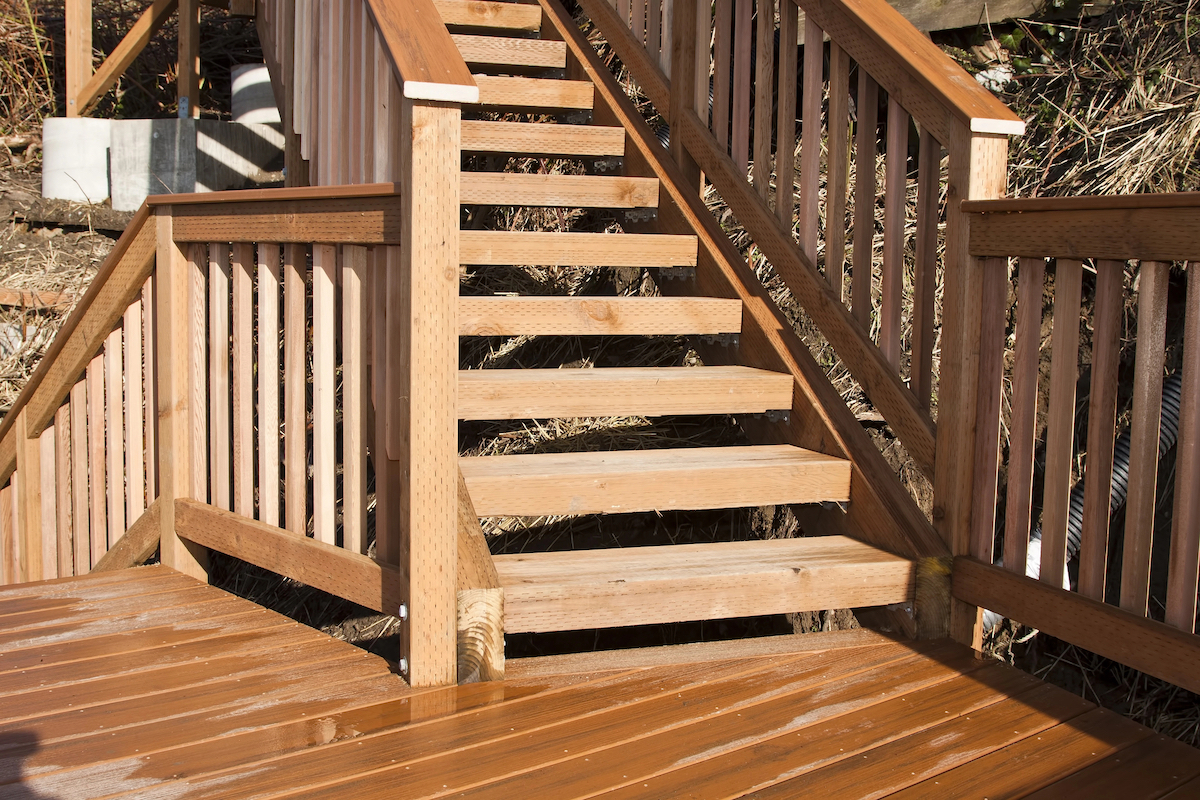
If you’re planning to clean deck stairs and rails, use the remaining homemade cleaner or mix a new batch.
- Railing: Apply and scrub with a bristle brush that works for the rail size. Be sure to rinse the newly cleaned surfaces, along with any areas of the deck on which water and soap dripped.
- Stairs: When cleaning deck stairs, scrub (and rinse) working from the top step to the bottom.
DIY Deck Cleaner Safety Tips
Knowing what is the best homemade deck cleaner helps any deck owner easily clean and maintain their deck. Even though the homemade deck cleaner above is nontoxic, follow these tips for best success and safest use.
- Do not use homemade deck cleaner with a power washer or pressure washer. Power washers and pressure washers have tiny nozzles that create intense water pressure, so any granular cleaner that doesn’t wholly dissolve can clog the nozzle, rendering the washer useless. A regular garden hose is more than sufficient to rinse away this homemade cleaner.
- Wear gloves when making the cleaner to protect your skin and hands. Cleaners and boosting agents like Borax may cause skin irritation in high concentrations. It’s a good idea to wear rubber gloves while mixing and applying even this nontoxic deck-cleaning solution. If splashes do get on your skin, simply rinse them off.
- Do not mix ammonia-based ingredients with bleach. Some products can be safely combined, but don’t mix a product that contains ammonia with a bleach solution, including oxygen bleach. Combining the chemicals creates toxic chloramine gas that can cause eye, nose, mouth, and respiratory irritation.
- Store your homemade deck cleaning mixture in a well-ventilated area. This DIY deck cleaner isn’t considered a toxic chemical but it will still create an odor, which some may find disagreeable. Since it’s designed for outdoor use, keep it outdoors until using it to clean the deck and then dispose of any leftovers. Make a fresh batch each time you clean the deck.
- Keep your solution out of reach from children and pets. Kids are curious, and a bucket of warm sudsy solution may look like something interesting to play with. While this homemade deck cleaner is mild—as far as deck cleaners go—it’s still a cleaner and, like all cleaners, should be kept out of the reach of children. Plus, even though OxiClean is safe to use for cleaning pet bedding, keep pets away from the mix or while scrubbing the deck.
Deck Maintenance Tips
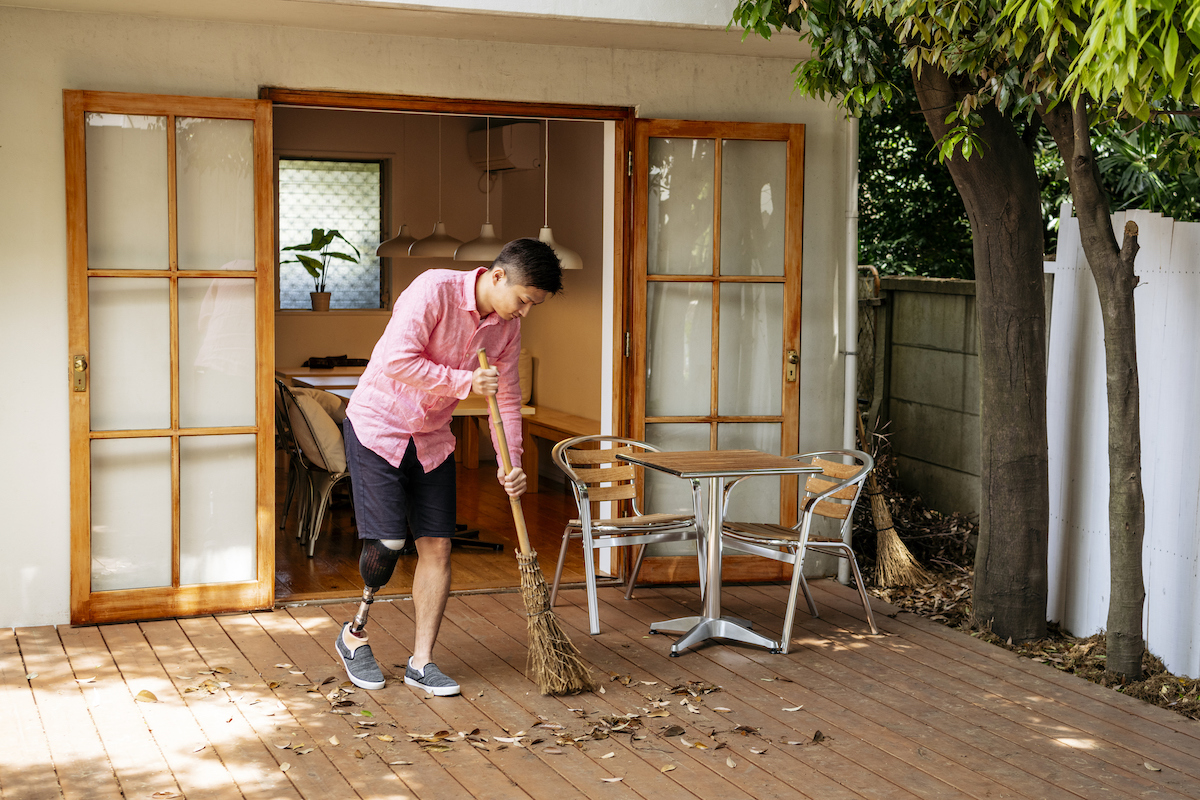
Keep your deck refreshed between annual cleanings with a little time spent on regular deck maintenance and repair. Doing so also can lessen the amount of scrubbing or stain removal needed the next time you mix and apply homemade deck cleaner.
- Sweep away dirt promptly. A light sweeping or use of a cordless blower—daily, ideally—can rid the deck of loose dirt, leaves, and other debris before it can be ground into the wood surface, decreasing how often to clean a deck.
- Treat stains with oxygen bleach paste. If a stubborn stain appears between cleanings, use an OxiClean paste and a stiff-bristle brush; leave the paste on for 30 minutes, then rinse.
- Keep mildew away with Borax. Borax is a natural mineral compound. In small quantities, it won’t damage nearby landscaping. Mix it into your homemade cleaner as needed to regularly fight mildew on deck surfaces.
- Apply a penetrating sealer once a year. Wood, even pressure-treated decks, will eventually succumb to harsh UV rays, wet/dry cycles, and temperature fluctuations. Add years of useful life to your wood surfaces by sealing the deck annually. The best time to apply a sealer is after a thorough deck cleaning.
When your deck is cleaned and well maintained, you will better enjoy your outdoor space. This is especially true if you are taking steps to upgrade your outdoor living areas to welcome friends and family.

